Braun Paxette - Braun/Nornberg
posted 2-19-'04
This camera manual library is for reference
and historical
purposes, all rights reserved.
This page is copyright© by
 , M. Butkus,
NJ.
, M. Butkus,
NJ.
This page may not be sold or distributed without
the expressed
permission of the producer.
I have no connection with any camera company.
On-line camera manual library
If you find this manual
useful,
how about a donation of $3 to:
M. Butkus, 29 Lake Ave.,
High Bridge, NJ 08829-1701
and send your
e-mail address
so I can thank you.
Most other places would charge
you $7.50 for a electronic copy
or $18.00 for a hard to read Xerox copy.
This will help me to continue to host this site,
buy new manuals,
and pay their shipping costs.
It'll make you feel better, won't
it ?
If you use Pay Pal, use the link below.
Use the above address for a
check, M.O. or cash.
Back to
main camera manual page
CLICK HERE FOR OTHER
PAXETTE CAMERAS
CLICK HERE FOR A
Braun Paxette PDF
VERSION OF THIS PAGE
CLICK HERE FOR A WORD VERSION OF
PAXETTE HTML PAGE

It is first of all necessary to become thoroughly familiar
with the various parts of the camera. Before inserting a film go over the
necessary operations several times. Good snapshots can only be achieved if
your Paxette is ready for instant action.
Key to numbers on opposite page.
1. Film locking stud
2. Film Counter
3. Knob for winding on film and winding
shutter
4. Optical exposure meter
5. Shutter setting
6. Socket for cable release
7. Shutter release lever
8. Lens aperture control
9. Locking ring
10. Tripod hush (1/4' Whitworth)
11. Film rewinding knob
12. Optical eye level view finder
13. Depth of field ring
14. Focusing ring
15. Flash socket
16. Delayed action release |
 |
The Paxette camera is made by
Carl
Braun K. G. of Nuremberg under the most modern conditions.
The beautiful finish of the Paxette is
the first evidence of the quality of the plant and the skill and care of the
operatives which lie behind its production. Actual use of the camera very
quickly confirms the first impression. It will be found delightful to handle,
thoroughly reliable and an instrument capable of producing the most perfect
pictures.
Careful study of this booklet is necessary to get the
best out of this camera. Once the mechanical details are mastered every
photographic problem can be faced with confidence and the Paxette
will become a constant friend and companion of leisure hours.
How to Open the Camera
 |
The milled locking ring
on the bottom of the camera is released by turning anti-clockwise. The back
and bottom of the camera can then be slid out. |
How to insert the film cassette
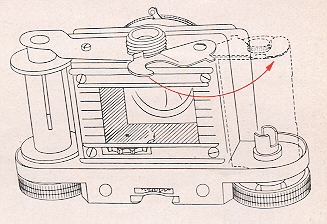 |
The arm which retains the
cassette is swung outwards by about 90° and the cassette is engaged in the
REWIND dog. The lever holding the cassette is then swung back again so that
it fits over the protruding spool knob.
|
Attention!
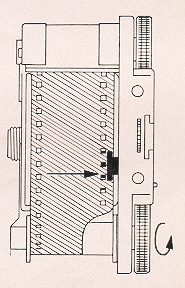 |
When film is inserted, it
is imperative that the margin of the film is sliding underneath the guide
spring at the right side of the cog-wheel. |
How to insert the film
 |
Pull out the film from
the cassette sufficiently far for the trimmed end to be inserted into the
slot of the empty spool and then bent back on itself so that it cannot slip.
Turn the film winding knob in the direction of the arrow until the sprocket
of the film transport engages with the perforations of the film. As the
turning of the film winding knob causes the shutter to be wound, the shutter
release ]ever should be operated every so often whilst winding is in
progress. This will enable the film to be wound on. Once the perforations
have engaged the sprocket, the back of the camera should be replaced and
locked. |
Warning: Direct sunlight should be avoided when loading with film.
If there is no shade, the operator's own shadow in better than direct sunlight.
How to close the camera.
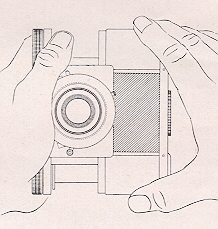 |
To close the camera the
back should be inserted between the camera housing and front plate and the
locking ring tightened. |
The film Counter
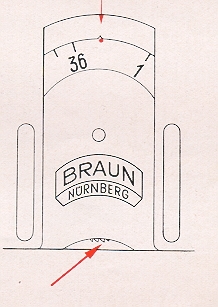 |
The film counter reads
backwards from 36 to 1. It thus indicates the number of unexposed frames
still available. After the film has been loaded and the camera has been
closed, the counter should be set at the red dot near the figure 36, by
means of the projecting teeth. The film winding knob is then turned until
the reading is 36. It is necessary to release the shutter to allow the film
to wind on. |
Film Winding and Film Transport
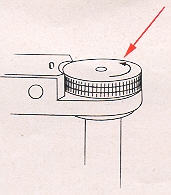 |
The shutter winding
mechanism, film transport and film counter are coupled so that they are
operated when the winding knob is wound in the direction of the arrow. After
the shutter has been released and until the camera has been re-wound, the
safety device which prevents double exposure is in operation. |
How to unload the Camera
 |
The whole length of the
film has been exposed when the counter reads figure 1 and the shutter has
been released.
To wind back the film, press the locking
stud; pull out the rewind knob as far as it will go and turn it in the
direction of the arrow. Towards the end of the film a somewhat stronger
resistance is felt which indicates that the film is being held by the take
up spool. |
A few further turns will then wind the film completely into
the cassette, and the camera can be opened for insertion of a new film.
Note: The locking stud must remain depressed throughout the whole rewinding
operation. It throws the sprocket out of gear.
Loading and Unloading Drill
1. Open the camera
2. Insert film cassette
3. Attach the film to the take-up spool
4. Close the camera
5. Set the film counter on the red dot
near 36
6. Wind on until 36 is against the index
mark |
1. Press down locking
stud throughout the winding operation
2. Raise rewind knob as far as it will
go
3. Turn rewind knob in the direction of the arrow
4. Wind the whole of the film into the
cassette
5. Open the camera
6. Remove the cassette |
Checking the film transport
 |
To make sure that the
film transport is functioning properly and the film really being wound on,
lift the rewind knob as far as it will go. If the film transport is
functioning properly the rewind knob will turn in the opposite direction
during winding operations.
Checking the Re-winding
To check the rewinding, release the
locking stud during rewind operations. It will then stand proud and there
should be a strong resistance if the mechanism is working correctly.
Warning. If force is used against this resistance the
perforation of the film will tear. When continuing to rewind, press
home the locking stud. |
The Lens Diaphragm
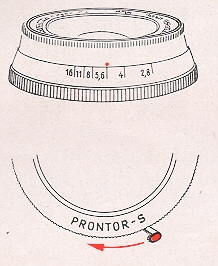 |
The lens aperture or
diaphragm is set by means of the front ring on the lens. Bring the red dot
into register with the black line at whatever setting is required.
Note: The smaller the aperture number the more light is
admitted, but the more limited is the depth of field. The
larger the aperture number, the less light passes, but the greater the depth
of field. For example. f/2.8 passes more light than f/16 but the depth of
field is much less. |
Delayed Action Release for Self Portraitures
The delayed action release is fitted to the bottom of the shutter and is set
by moving the lever as far as it will go.
Warning: The delayed action release cannot be used with "B" setting (time).
It would damage the shutter.
The Optical
Exposure Meter
 |
There are three rows of
figures of different density inside the exposure meter (right hand eye
piece). With the eye piece held close to the eye, aim the camera at the
subject to be taken. The highest figure which is discernible after looking
through the eye piece for about 20 seconds will be the light value and is
the basis for reading off the exposure time from the exposure tables on the
camera case. |

How to Read the Exposure Time from the Exposure
Table
Example. Assuming that the figure 10 is the highest
discernible figure in the exposure meter, refer to the table which is
attached to the back of the camera case and look for figure 10 in the top
horizontal row. The left-hand vertical row, in front of the thick black line
gives the apertures from the 2.8 to 16. It is then possible to read off the
exposure times for each aperture from the vertical row running down from the
figure 10. Assuming that aperture 16 has been chosen (smallest aperture),
the reading in the vertical line under the figure 10 for aperture 16 will be
1/10 second. For aperture 11 an exposure time of 1/25 second would be
required, for aperture 8, 1/5n second, for aperture 5.6, 1/100 second and
for aperture 4, 1/300 second. No exposure time for aperture 2.8 is given
because for this light value (10) so large an aperture would be unsuitable.
The same procedure should be adopted for all other light values.
Note: The table is compiled for film with a sensitivity of 17/10 DIN.
For 21/10 DIN the exposure times should be halved and for 13/10 DIN they
should be doubled.
The corresponding values for other sensitivity scales
may be taken to be as follows:
| DIN |
SCHEINER |
WESTON |
ASA/BS |
21/10
17/10
13/10 |
31
27
23 |
64
25
10 |
12
32
80 |
How to Focus
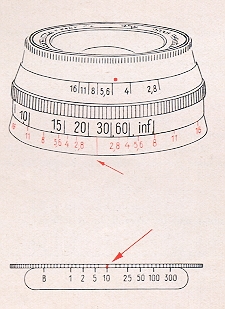 |
After estimating the
distance between the camera and the subject to be taken or after
ascertaining it by means of a range finder (which can be mounted on the
camera), the second milled ring situated on the lens is turned to register
with the line which will be found in the middle of the fixed ring engraved
in red. The scale of the distance setting ranges from 3'/2 ft. to infinity.
Exposure Time
The shutter is set by bringing the red line on the milled ring of the
shutter into register with the desired speed which is engraved on the
collar on top of the shutter housing.
|
The Depth of Field
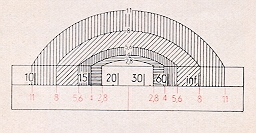 |
The depth of field
comprises the area which is sharply defined by the lens, from the foreground
to the background. This area or depth varies according to the aperture
chosen, that is to say, a large aperture (f/2.8) gives less depth of field
and a small aperture (f/16) gives a greater depth of field. The depth of
field for every aperture setting can be read off the red scale on the middle
ring of your Paxette. |
This repeats on the left and on the right on
the centre LINE, the range of lens apertures.
Examples . If the focus is set between 20
and 30 ft., everything will be sharp from down 60 ft. to about 15 ft. when
working with an aperture of f/4. If working at f/8 however, everything will be
sharp from infinity down to 12.5ft.
 |
The Palette
should be held firmly in both hands so that the rounded bottom edge is
resting on the palms of the hands. When the shutter is released, the left
hand will then be keeping the camera steady.
The camera and the hand should be pressed against the head and a broad
stance adopted to ensure steadiness. Another point to observe is that the
ball of the right hand should exert slight counter pressure whilst the
second finger of the right hand presses the trigger. |
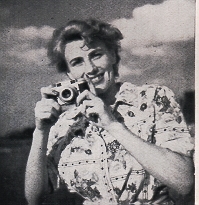 |
This should be done
gently and without jerking. Move the finger only and not the whole hand.
Allow the finger to rest on the release lever until the release has run off.
Remain calm whilst taking a picture especially when taking snapshots with
the Paxette.
Good results amply repay the trouble
taken. |
If the Paxette
should happen to go wrong, the temptation to get a screwdriver and open it up
should be resisted. The correct assembly of, say, the shutter or the
relationship of the lens to the focal plane are most delicate matters, and even
a skilled mechanic not accustomed to cameras should hesitate. A faulty camera
should not be touched but should be handed to a good photographic dealer who has
a specialist repairer with special tools at his disposal.
| Camera |
Format |
Lens |
Shutter |
| Paxette |
24 x 36 mm |
f/2.8 |
Pronter S 9 - speeds
delayed action : flash |
| Paxian I |
6 x 6 cm |
f/7.7 |
3 - speed (B - 1/25 -
1/100) |
| Pacian II |
6 x 6 cm |
f/3,5 |
Vario 4 - speed : flash |
| Inperial Box |
cameras for 2 1/2" x 2
1/2" |
and 2 1/4" x
3 1/4" with and without flash |
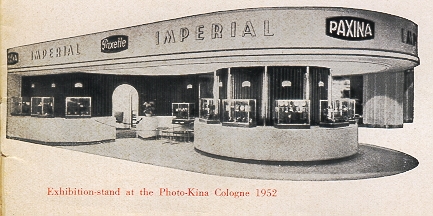
![]() , M. Butkus,
NJ.
, M. Butkus,
NJ.


















